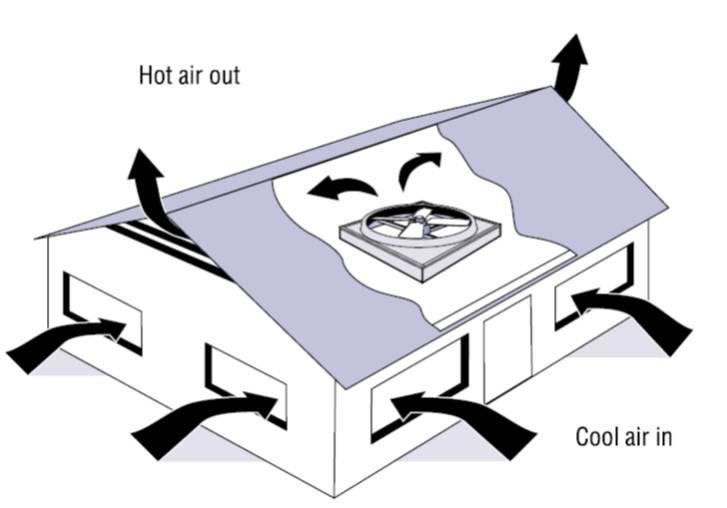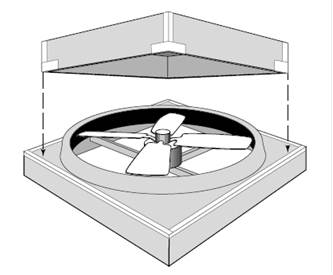Air Sealing Whole-House Fans
Scope
Air seal whole-house fans to minimize air leakage.
- Install a whole-house fan that is equipped with an insulated cover to meet or exceed R-10.
- Install an insulated and gasketed cover on the house side or install a cover that is mechanically operated.
- Seal all gaps and holes to unconditioned space with caulk or foam.
- Whole-house fans are most effective in climates with hot days, cool nights and relatively low humidity.
See the Compliance Tab for related codes and standards requirements, and criteria to meet national programs such as DOE’s Zero Energy Ready Home program, ENERGY STAR Certified Homes, and Indoor airPLUS.
Description
A whole house fan is a fan installed in the ceiling to help quickly cool the house by drawing air into the house through open windows on summer mornings and evenings when the outside temperature is lower than the indoor temperature. The fan pulls hot air out of the house and dumps it into the vented attic, or the fan can be ducted to vent directly outdoors. The whole house fan can provide an economical alternative to air conditioning in dry climates with large day-night temperature swings; however, a whole-house fan requires active homeowner participation to turn the fan on and off and to open windows while it is in operation. If windows are not opened during operation, cool air won’t be drawn in and the home can quickly become depressurized, which could backdraft any non-direct-vented combustion appliances.
The fan should be located on a horizontal ceiling at or near the center of the house, for example at the top of the stairs in a two-story house. When necessary, some fan models can be installed vertically in exterior walls or attic knee walls.
During the winter months (and in summer when air conditioning is used), a whole house fan represents a potential energy loss because it is essentially a large, uninsulated hole in the ceiling. Whole house fans with insulated motorized dampers are available; these dampers act as a two-piece insulating cover that opens up into the attic when the fan is in operation and close when the fan is turned off. If the fan does not come with an insulated motorized damper/cover, an insulated cover should be purchased or constructed for it. The cover will have to be removed by the owner during seasons when the fan is in use, so the design should be constructed so that it can be opened and closed from inside the house without accessing the attic. Alternatively, an insulated cover can be constructed that installs on the house side of the fan.
Other Considerations
Because whole house fans can draw large amounts of air out of the home (rated airflows of 750 cfm to 10,000 cfm are typical), the whole house fan can quickly depressurize the house if there are not enough windows open. It can also pull in air from outside, from the garage, from the crawlspace. So in addition to air sealing the fan itself, it is important to ensure that all potential air leaks between the home and outside, especially the garage and crawlspace, are properly air sealed to prevent drawing air in from those locations. Since whole house fans exhaust relief air into the attic, essentially pressurizing the attic, it is also important to air seal between the house and the attic to prevent attic air from leaking back into the house (Springer et al. 2012). Combustion appliances that draw room air for combustion are not recommended inside homes where a whole house fan will be operating; combustion appliances should be sealed combustion with their combustion air coming from outside.
The attic must have adequate venting. One square foot of net-free vent area per 750 cfm of fan airflow is recommended; continuous ridge and soffit vents are usually adequate (Southface-ORNL 1999). Security concerns should be taken into account when considering installing a whole house fan; windows must be left open during operation with a recommended minimum of four square feet of open window or door area for each 1,000 cfm of fan airflow (Springer et al. 2012). Other nighttime cooling equipment is available that uses electronic controls and a dampered outside air intake ducted to the home’s central air handler to draw in, filter, and automatically circulate cool nighttime air taking advantage of day-night temperature differences in dry climates without opening windows. Because they draw in so much outside air, whole house fans are not effective in humid climates.
How to Install and Air Seal a Whole House Fan
- Verify adequate ventilation in attic, thorough air sealing of home’s building envelope, that no combustion appliances are located in the attic, and that no atmospheric-vented combustion appliances are located in the home (Springer et al. 2012).
- Determine a location for the fan on a horizontal ceiling at or near the center of the house, for example at the top of the stairs in a two-story house.
- Select a fan that will fit the ceiling joist spacing, i.e., one that is either 16 inches or 24 inches wide. . Do not cut ceiling joists to install the fan. Verify that there is a circuit available for connecting power to the fan. If the fan has an insulated cover that opens into the attic, , verify that the cover will have room to open. Install the fan prior to blowing attic insulation.
- Frame out the ceiling joists (or lower truss members) to the size required by the fan manufacturer. Use framing lumber that matches the depth of the ceiling joists.
- Cut the drywall opening no larger than required for the fan, as the louver frame or grill will not cover the cut-out edges. Some manufacturers provide templates for this purpose.
- Seal the joints between the frame-out and the ceiling drywall with spray foam or caulk. Inspect the fan box itself and seal any noticeable gaps. Use foam weather stripping or spray foam to create a seal between the fan box and the frame-out and drywall.
- Position the fan box on or in the frame-out as required and secure it in accordance with the manufacturer’s instructions.
- Wire the whole house fan and controls according to the manufacturer’s instructions.
- At the ceiling below the fan, install the louver frame or grille.
- Install plywood or manufacturer-supplied material around the fan box to prevent loose fill insulation from falling into the fan (Springer et al. 2012).
- If the whole house fan does not have a built-in insulated damper/cover, construct a cover that attaches to the ceiling side of the fan. Use rigid foam, Velcro, a threaded bolt and wingnut (see Figures 2 and 3).
- Alternatively or in addition, purchase or construct a fan cover that can be lifted without the homeowner climbing into the attic. Make a box-shaped cover from rigid foam insulation and foil tape. Weather strip the bottom edge. Attach a tag to the underside of the fan reminding the homeowner that the attic-side cover is in place and must be removed during operation.

Figure 1 - Whole house fans draw cool night-time air in through open windows and expel hot house air into the vented attic for cooling energy savings in dry climates with large day-night temperature differences ![]()

Figure 2 - The whole house fan is installed in the ceiling in a central location in the house. The housing is air sealed to the ceiling drywall. ![]()

Figure 3 - A cover can be constructed to be installed on the house side of the fan ![]()

Figure 4 - Some whole-house fans include a built-in insulated cover that opens automatically when the fan is switched on ![]()

Figure 5 - If the fan does not have a built-in attic side cover, a cover can be purchased or constructed from rigid foam and foil tape to cover the fan from the attic side during seasons when the fan is not in use. Use weather-stripping to air seal the cover to the fan box. ![]()
Ensuring Success
Inspect the whole house fan to ensure that it is equipped with an insulated and gasketed cover on the house side or an insulated cover on the attic side that can be mechanically opened and closed from the house side. Some localities will not permit a whole house fan to be installed if a furnace is located in the attic or if there is a combustion appliance in the home that derives its combustion air from either the attic or the inside of the home unless the homeowner:
- encloses the combustion appliance so that it obtains combustion air from outside the home;
- ducts the whole house fan directly to the exterior; or
- provides a switching device that allows only one of the appliances (fan or furnace) to be on at a time (Davis 2001).
The home’s building envelope must be thoroughly air sealed to prevent outside air, especially from the garage, crawlspace, or attic, from being drawn into the house during fan operation. The attic must have adequate venting.
Climate
No climate specific informaiton applies.
Training
CAD Images
-
SourceReference: Building Plans for Advanced FramingOrganization(s): Green Building Advisor
Website providing CAD files and drawings of advanced framing details.
SaveDownloadDownload PDFDownload PDF
Compliance
ENERGY STAR Certified Homes (Version 3/3.1, Revision 08), Rater Field Checklist
Thermal Enclosure System:
4. Air Sealing (Unless otherwise noted below, "sealed" indicates the use of caulk, foam, or equivalent material).
4.10 Attic access panels, drop-down stairs, & whole-house fans equipped with durable ≥ R-10 cover that is gasketed (i.e., not caulked). Fan covers either installed on house side or mechanically operated.28
Footnotes:
(28) Examples of durable covers include, but are not limited to, pre-fabricated covers with integral insulation, rigid foam adhered to cover with adhesive, or batt insulation mechanically fastened to the cover (e.g., using bolts, metal wire, or metal strapping).
ENERGY STAR Revision 08 requirements are required for homes permitted starting 07/01/2016.
Exhibit 1: Mandatory Requirements. Certified under ENERGY STAR Qualified Homes Version 3. EPA Indoor airPLUS Verification Checklist.
Air sealing of whole-house fans is not specifically addressed in the 2009 IECC.
Air sealing of whole-house fans is not specifically addressed in the 2009 IRC.
Air sealing of whole-house fans is not specifically addressed in the 2012 IECC.
Air sealing of whole-house fans is not specifically addressed in the 2012 IRC.
More Info.
Tight Air Sealed Home = Comprehensive Draft Protection
Alternate Terms
Sales Message





